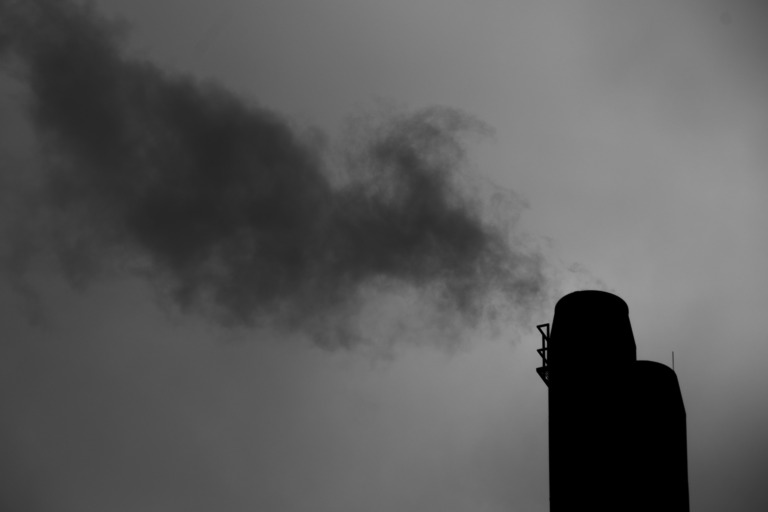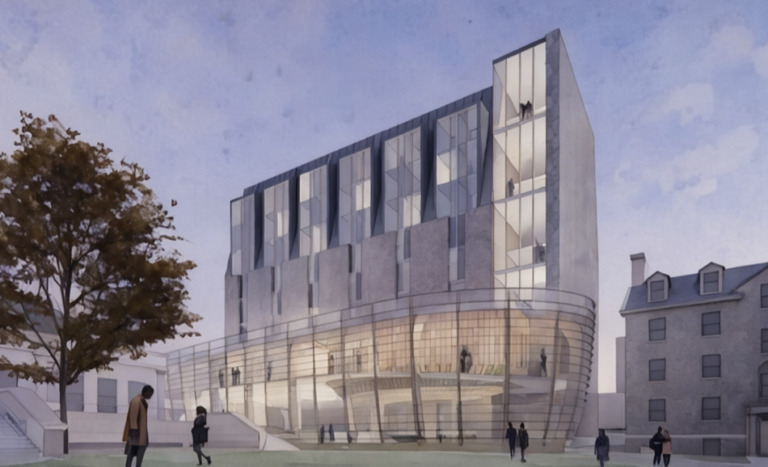
By Hilary Beaumont, Copy Editor
Paint fumes lingered in the halls of the Life Sciences Centre and circulated through the building Wednesday. Painted concrete walls are the first sign of a $27-million building upgrade Dalhousie intends to complete by early 2011. The plan includes a revamped ventilation system.
But many faculty members who work in the building say cleaner air is long overdue.
As he sat in his second-floor Life Sciences Centre (LSC) office Wednesday afternoon, Peter Wallace pointed at the rough, exposed wall beside the door.
“It’s a concrete building. You’ll always have problems with dust … that’s a problem with any concrete building unless you finish the concrete with paint.”
Dust is just one of many air quality concerns the Dal geology professor has. When trucks idle at the loading dock behind the building, Wallace smells the fumes. The system sucks them up and dumps them in his department.
“Twice or three times a day I smell diesel fumes,” Wallace said.
His students comment on the fumes during class.
“They’re quite noticeable,” he said. “Last week it was incredible. It was like the diesel truck was right outside the door.”
Other smells travel too – the stench of fish from the biology department and the fragrance of fries from the cafeteria.
Wallace has minor allergic reactions to scented products, such as hair mousse and perfumes, which regularly venture through the vents. When they reach his nose, his heart palpitates and he sweats more. That makes him uncomfortable and changes his mood. But he said it won’t kill him.
“Because it’s recycled air, there’s a lot of smells that float around and go through. You can’t get rid of it.”
Wallace wonders if the recycled air system could potentially spread viruses.
“You live in an unhealthy building, you have unhealthy people.”
He said air problems could be easily solved if the building had windows that could open. But the circulation in the building relies on a closed environment.
The proposed retrofit does not include plans to change the windows. Instead it will receive a new air circulation system and pressurized doors to keep the heat from escaping.
In the late ‘80s and early ‘90s, Wallace said a group of faculty members complained about the building’s air quality and humidity. At the time, Dal wanted to respond to their concerns, he said, but the university didn’t have the budget for upgrades. Most faculty members have since given up the fight for cleaner air.
A staff technician, who works in the building, said he called Dal’s Health and Safety Office regularly for 10 to 15 years to complain about unhealthy exhaust fumes, garbage smells, dust and cigarette smoke in his office due to the building’s poor ventilation system.
The technician asked that his name not be included in the story because he fears repercussions if he openly criticizes Dalhousie.
“(The technician) used to call all the time,” said Jan McIntyre, secretary of the Health and Safety Office. “Now he doesn’t call anymore.”
The office does not keep records of health complaints. McIntyre couldn’t say how many phone calls she had received about the building’s air quality.
“Concrete surfaces are very depressing, and when we have the real humid weather sometimes the air gets really stale,” said McIntyre. “There are issues (with) the oceanography loading dock, there used to be idling engines and that would come through.”
When someone calls to complain, the office sends a supervisor to the building to solve the problem. Often the supervisor will simply ask the drivers at the loading dock to stop idling, or ask the smokers to move elsewhere.
Raymond Ilson, who has worked as director of the Dalhousie Health and Safety Office for a year and a half, said he hasn’t heard any complaints about the air quality in the building.
He has never been asked to do an air quality assessment in the building.
However, he said there are no air quality sensors in the Life Sciences Centre. His office relies on people to report air quality problems.
Ilson received a call that asbestos was found in the building, but he said it has since been cleaned up.
“Maybe people are just suffering,” he said. “They don’t tell us.”
Lauren Edwards, a Dal kinesiology student who takes classes in the building, has also noticed the ventilation problems.
“Being in the LSC is like being in an underground bunker,” she said. “Constant darkness and poor air quality.”
The dust hasn’t bothered her.
“I was just there and the air just feels so thick and it can’t possibly be fresh. It’s hard to breathe because it’s so thick and warm.”
“That’s precisely why we’re tackling this,” said Charles Crosby, Dal’s media relations manager. “(A new ventilation system) is one of the main priorities. And we’ve been hearing that for a while. We’ve needed to address it and we’re addressing it.”
The $27 million comes from the provincial and federal governments’ Knowledge and Infrastructure Program. It will help reduce the LSC’s ecological footprint and address environmental concerns, he said.
Dalhousie built the LSC between 1969 and 1971 as part of a construction boom that included the Killam Library, the Student Union Building, the law school and the arts centre. Designed by Ray Affleck, a celebrated architect, the buildings were considered by many at the time to be innovative, and fresh.
Today, about 200 researchers, 450 research students and 3,000 undergraduate students regularly use the building, according to DalNews, the university’s public relations pamphlet.
“It’s been a number of years where we’ve heard different kinds of issues coming out of the building, including the way the building was designed,” Crosby said. “We’ve needed to tackle the building in a systemic way for a while, but the matter was resources to be able to do that. Now we have the resources, we’re doing that on a relatively quick timeline.”
Wallace isn’t holding his breath for drastic changes in the building’s air quality by 2011.
“I’m cynical. I don’t think they’re going to improve a damn thing. The only way they can improve this building – which is near impossible because of the way it’s built – is really just to change the windows, make them open-able, change the whole system around.”
Soon he won’t have to tolerate the Life Sciences Centre. After 31 years, the tenured professor is retiring.
“A good thing to clean this up would be a good bomb to start it all over again,” he jokes.
This article was first published by UNews.ca, a King’s Journalism School website that covers campus news in Nova Scotia.






